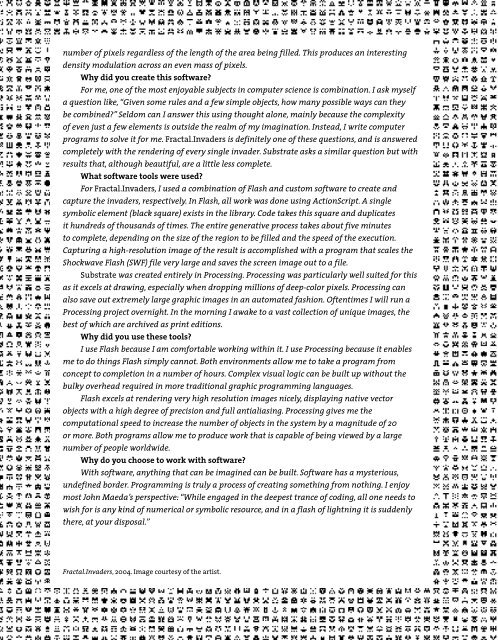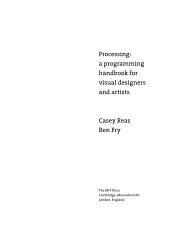Fractal.Invaders, Substrate (Interview with Jared Tarbell) - Processing
Fractal.Invaders, Substrate (Interview with Jared Tarbell) - Processing
Fractal.Invaders, Substrate (Interview with Jared Tarbell) - Processing
Create successful ePaper yourself
Turn your PDF publications into a flip-book with our unique Google optimized e-Paper software.
number of pixels regardless of the length of the area being filled. This produces an interesting<br />
density modulation across an even mass of pixels.<br />
Why did you create this software?<br />
For me, one of the most enjoyable subjects in computer science is combination. I ask myself<br />
a question like, “Given some rules and a few simple objects, how many possible ways can they<br />
be combined?” Seldom can I answer this using thought alone, mainly because the complexity<br />
of even just a few elements is outside the realm of my imagination. Instead, I write computer<br />
programs to solve it for me. <strong>Fractal</strong>.<strong>Invaders</strong> is definitely one of these questions, and is answered<br />
completely <strong>with</strong> the rendering of every single invader. <strong>Substrate</strong> asks a similar question but <strong>with</strong><br />
results that, although beautiful, are a little less complete.<br />
What software tools were used?<br />
For <strong>Fractal</strong>.<strong>Invaders</strong>, I used a combination of Flash and custom software to create and<br />
capture the invaders, respectively. In Flash, all work was done using ActionScript. A single<br />
symbolic element (black square) exists in the library. Code takes this square and duplicates<br />
it hundreds of thousands of times. The entire generative process takes about five minutes<br />
to complete, depending on the size of the region to be filled and the speed of the execution.<br />
Capturing a high-resolution image of the result is accomplished <strong>with</strong> a program that scales the<br />
Shockwave Flash (SWF) file very large and saves the screen image out to a file.<br />
<strong>Substrate</strong> was created entirely in <strong>Processing</strong>. <strong>Processing</strong> was particularly well suited for this<br />
as it excels at drawing, especially when dropping millions of deep-color pixels. <strong>Processing</strong> can<br />
also save out extremely large graphic images in an automated fashion. Oftentimes I will run a<br />
<strong>Processing</strong> project overnight. In the morning I awake to a vast collection of unique images, the<br />
best of which are archived as print editions.<br />
Why did you use these tools?<br />
I use Flash because I am comfortable working <strong>with</strong>in it. I use <strong>Processing</strong> because it enables<br />
me to do things Flash simply cannot. Both environments allow me to take a program from<br />
concept to completion in a number of hours. Complex visual logic can be built up <strong>with</strong>out the<br />
bulky overhead required in more traditional graphic programming languages.<br />
Flash excels at rendering very high resolution images nicely, displaying native vector<br />
objects <strong>with</strong> a high degree of precision and full antialiasing. <strong>Processing</strong> gives me the<br />
computational speed to increase the number of objects in the system by a magnitude of 20<br />
or more. Both programs allow me to produce work that is capable of being viewed by a large<br />
number of people worldwide.<br />
Why do you choose to work <strong>with</strong> software?<br />
With software, anything that can be imagined can be built. Software has a mysterious,<br />
undefined border. Programming is truly a process of creating something from nothing. I enjoy<br />
most John Maeda’s perspective: “While engaged in the deepest trance of coding, all one needs to<br />
wish for is any kind of numerical or symbolic resource, and in a flash of lightning it is suddenly<br />
there, at your disposal.”<br />
<strong>Fractal</strong>.<strong>Invaders</strong>, 2004. Image courtesy of the artist.<br />
158 <strong>Interview</strong>s 1: Print



